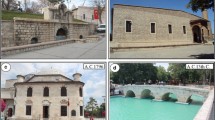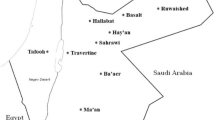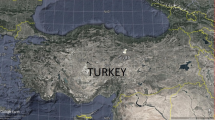Abstract
Many churches have been constructed during the last two millennia in the Cappadocia region of Central Anatolia. Among these buildings, the Küçükköy Church, constructed in 1834, is distinguishable from other churches by its icons and distinctive roof. However, this monument is in a state of rapid deterioration due to its derelict status, local atmospheric conditions, and the geological characteristics of the stones used in the structure. It is therefore important to determine deterioration status and the amount of deterioration of each building stone to facilitate the sustainable preservation of this monument. In recent years, non-destructive tests (NDT) have been commonly used to evaluate the detrioration status of such historic buildings. In the study reported here, we conducted laboratory studies on stone samples and performed in situ NDT (P-wave velocity test, Schmidt hammer rebound [SHR] test, and surface moisture measurement test) to determine the deterioration status of building stones used in the Küçükköy Church. The lithological characteristics of building stones are known to be the most important parameters in the deterioration process. We found that the deterioration effects were most advanced in those building stones which had properties similar to one type of andesite, as demonstrated by high voids and low P-wave velocity and SHR values. The benefits of NDT is that they are repeatable and that reliable results are obtained rapidly and economically.











Similar content being viewed by others
References
Abbaneo S, Berra M, Binda L, Fatticcioni A (1995) A non destructive evaluation of brick–masonry structures: calibration of sonic wave propagation procedures. In: Proc Int Symp of Non Destructive Testing in Civil Engineering (NDT-CE). Deutsche Gesellschaft für Zerstörungsfreie Prüfung, Berlin, p 253–260
Açıkgöz F, Demir F, Eryaman M, Tektaş M (2009) Niğde Kültür Envanteri (1). Tekten Basın Yayın Ltd. Şti, Niğde
Akin M, Özsan A (2011) Evaluation of the long-term durability of yellow travertine using accelerated weathering tests. Bull Eng Geol Environ 70:101–114. https://doi.org/10.1007/s10064-010-0287-x
Anzani A, Binda L, Carpinteri A, Invernizzi S, Lacidogna G (2010) A multilevel approach for the damage assessment of historic masonry towers. J Cult Herit 11:459–470. https://doi.org/10.1016/j.culher.2009.11.008
Aoki H, Matsukura Y (2007) A new technique for non-destructive field measurement of rocksurface strength: an application of the Equotip hardness tester to weathering studies. Earth Surf Process Landf 32:1759–1769. https://doi.org/10.1002/esp.1492
ASTM International (2014) D5873 standard test method for determination of rock hardness by rebound hammer method. ASTM International, West Conshohocken
Atabey E, Göncüoğlu MC, Turhan N (1990) 1/100.000 ölçekli açınsama nitelikli Türkiye jeoloji haritaları serisi KOZAN-J 19 paftası. MTA Genel Müdürlüğü, Ankara
Aydin A, Basu A (2005) The Schmidt hammer in rock material characterization. Eng Geol 81:1–14. https://doi.org/10.1016/j.enggeo.2005.06.006
Batum I (1978) Nevsehir guney batisindaki Gollu Dag ve Acigol volkanitlerinin jeokimyasi ve petrolojisi. [Geochemistry and petrology of Gollu Mountain and Acigol Volcanics of southwest Nevsehir.]. J Earth Sci 4:70–88
Beekman P (1966) The Pliocene and Quaternary volcanism in the Hasan Dağ-Melendiz Dağ region Maden Tetkik ve Arama Genel Müdürlüğü Bülteni 66:99–106
Binda L (1997) A role of riles committee: calibration of proposed test methods. In: Binda L, Modena C (eds) Evaluation and Strengthening of Existing Masonry Structures, 1st edn. RILEM Publications, Padua, pp 1–24
Bortz S, Stecich J, Wonneberger B, Chin I (1993) Accelerated weathering in building stone. Int J Rock Mech Min Sci Geomech Abstr 30:1559–1562. https://doi.org/10.1016/0148-9062(93)90156-8
Buj O, Gisbert J, Franco B, Mateos N, Bauluz B (2010) Decay of the Campanile limestone used as building material in Tudela Cathedral (Navarra, Spain). Geol Soc Spec Publ 331:195–202. https://doi.org/10.1144/sp331.17
Casula G, Fais S, Ligas P, Mora P (2007) Experimental application of 3-d terrestrial laser scanning and acoustic techniques in assessing the quality of stones used in monumental structures. In: I.N. Prassianakis (ed), Proc 4th international conference on NDT. Crete, p 118–122
Charola AE (2000) Salts in the deterioration of porous materials: An overview. J Am Inst Conserv 39:327–343. https://doi.org/10.1179/019713600806113176
Christaras B (1997) Estimation of damage at the surface of stones using non destructive techniques. WIT Trans Built Environ 26:121–128
Christaras B, Auger F, Mosse E (1994) Determination of the moduli of elasticity of rocks. Comparison of the ultrasonic velocity and mechanical resonance frequency methods with direct static methods. Mater Struct 27:222–228. https://doi.org/10.1007/bf02473036
Christaras B, Cuccuru F, Fais S, Papanikolaou H (2015) Application of non destructive ultrasonic techniques for the analysis of the conservation status of building materials in monumental structures. Eng Geol Soc Territ 8:139–143
Çobanoğlu İ, Çelik SB (2008) Estimation of uniaxial compressive strength from point load strength. Schmidt hardness and P-wave velocity. Bull Eng Geol Environ 67:491–498
Cuccuru F, Fais S, Ligas P (2014) Dynamic elastic characterization of carbonate rocks used as building materials in the historical city centre of Cagliari (Italy). Q J Eng Geol Hydrogeol 47:259–266. https://doi.org/10.1144/qjegh2013-061
Cultrone G, Luque A, Sebastián E (2012) Petrophysical and durability tests on sedimentary stones to evaluate their quality as building materials. Q J Eng Geol Hydrogeol 45:415–422. https://doi.org/10.1144/qjegh2012-007
De Beer J (1967) Subjective classification of the hardness of rocks and the associated shear strength. In: Proc 4th Reg Cong African Soil Mechanical Found Engineering. Capctawn, p 396–398
Ekiz M (2015) Niğde ili ve ilçeleri arkeolojik yüzey araştırması raporu. T.C. Kültür ve Turizm Bakanlığı, 57 sayfa. http://www.ttk.gov.tr/wp-content/uploads/2016/11/7-Nigde.pdf. Accessed 12 Jan 2018
El-Gohary M (2012) The contrivance of new mud bricks for restoring and preserving the Edfa Ancıent Granary-Sohag. Egypt Int J Conserv Sci 3:67–78
El-Gohary MA (2017) Environmental impacts: Weathering factors, mechanism and forms affected the stone decaying in Petra. J Afr Earth Sci 135:204–212. https://doi.org/10.1016/j.jafrearsci.2017.08.020
Esaki T, Jiang K (2000) Comprehensive study of the weathered condition of welded tuff from a historic stone bridge in Kagoshima, Japan. Eng Geol 55:121–130. https://doi.org/10.1016/S0013-7952(99)00112-X
Fais S, Casula G (2010) Application of acoustic techniques in the evaluation of heterogeneous building materials. NDT E Int 43:62–69. https://doi.org/10.1016/j.ndteint.2009.10.004
Fais S, Tocco R, Casula G (1999) ND acoustic techniques to assess the preservation of a church colonnade-a case history. In: 61st EAGE Conf and Exhibition. Helsinki, p 1–2
Fais S, Ligas P, Palomba M, Tocco R (2002) Evaluation of preservation state of monumental buildings by ND acoustic techniques and mineralogical studies. In: Proc 5th Int Symp, Conservation of Monuments in the Mediterranean Basin; Protection and Conservation of the Cultural Heritage of the Mediterranean Cities. Seville, p 307–314
Fener M, İnce İ (2015) Effects of the freeze–thaw (F–T) cycle on the andesitic rocks (Sille-Konya/Turkey) used in construction building. J Afr Earth Sci 109:96–106. https://doi.org/10.1016/j.jafrearsci.2015.05.006
Fookes PG, Dearman WR, Franklin JA (1971) Some engineering aspects of rock weathering with field examples from Dartmoor and elsewhere. Q J Eng Geol Hydrogeol 4:139–185
Fort R, Alvarez de Buergo M, Perez-Monserrat EM (2013) Non-destructive testing for the assessment of granite decay in heritage structures compared to quarry stone. Int J Rock Mech Min Sci 61:296–305. https://doi.org/10.1016/j.ijrmms.2012.12.048
Franzoni E, Bandini S, Graziani G (2014) Rising moisture, salts and electrokinetic effects in ancient masonries: From laboratory testing to on-site monitoring. J Cult Herit 15:112–120. https://doi.org/10.1016/j.culher.2013.03.003
Gökçe MV, İnce İ, Fener M, Taşkıran T, Kayabali K (2016) The effects of freeze–thaw (F–T) cycles on the Gödene travertine used in historical structures in Konya (Turkey). Cold Reg Sci Technol 127:65–75. https://doi.org/10.1016/j.coldregions.2016.04.005
Gokceoglu C, Zorlu K, Ceryan S, Nefeslioglu HA (2009) A comparative study on indirect determination of degree of weathering of granites from some physical and strength parameters by two soft computing techniques. Mater Charact 60:1317–1327. https://doi.org/10.1016/j.matchar.2009.06.006
Grinzato E, Marinetti S, Bison PG, Concas M, Fais S (2004) Comparison of ultrasonic velocity and IR thermography for the characterisation of stones. Infrared Phys Technol 46:63–68. https://doi.org/10.1016/j.infrared.2004.03.009
International Society for Rock Mechanics (ISRM) (1981) Suggested methods for determining hardness and abrasiveness of rocks. In: Brown ET (ed) Rock characterization, testing and monitoring: ISRM suggested Methods. Pergamon, Oxford, pp 95–96
ISRM (2007) The complete ISRM suggested methods for rock characterization, testing and monitoring: 1974–2006. ISRM Turkish National Group, Ankara
Jo YH, Lee CH (2014) Quantitative modeling and mapping of blistering zone of the Magoksa Temple stone pagoda (13th century, Republic of Korea) by graduated heating thermography. Infrared Phys Tech 5:43–50. https://doi.org/10.1016/j.infrared.2014.02.011
Kahraman S (2001) Evaluation of simple methods for assessing the uniaxial compressive strength of rock. Int J Rock Mech Min Sci 38:981–994
Koca MY, Kıncal C (2004) Abandoned stone quarries in and around the Izmir city centre and their geo-environmental impacts-Turkey. Eng Geol 75(1):49–67
Kocaman M (2016) Niğde'nin geç Dönem Osmanlı kiliseleri. Selçuk Üniversitesi Sosyal Bilimler Enstitüsü Yüksek Lisans Tezi, Konya, 535 sayfa
Korkanç M (2013) Deterioration of different stones used in historical buildings within Nigde province. Constr Build Mater 48:789–803
Korkanç M, Savran A (2015) Impact of the surface roughness of stones used in historical buildings on biodeterioration. Constr Build Mater 80:279–294. https://doi.org/10.1016/j.conbuildmat.2015.01.073
Korkanç M, Tuğrul A (2004) Evaluation of selected basalts from Niğde, Turkey, as source of concrete aggregate. Eng Geol 75:291–307. https://doi.org/10.1016/j.enggeo.2004.06.015
Korkanç M, İnce İ, Hatır ME, Tosunlar MB (2018) Historical Granaries at Taşkale (Turkey) Under Risk: A Geotechnical Analysis. MAA 18(1):149–162
Laurie JB, Robertson RHS, Vicente MA (1986) The restoration of buildings constructed with Menorcan limestone. Q J Eng Geol Hydrogeol 19:283–289. https://doi.org/10.1144/gsl.qjeg.1986.019.03.05
Lim MK, Cao H (2013) Combining multiple NDT methods to improve testing effectiveness. Constr Build Mater 38:1310–1315. https://doi.org/10.1016/j.conbuildmat.2011.01.011
López-Doncel R, Wedekind W, Dohrmann R, Siegesmund S (2013) Moisture expansion associated to secondary porosity: an example of the Loseros Tuff of Guanajuato, Mexico. Environ Earth Sci 69:1189–1201. https://doi.org/10.1007/s12665-012-1781-1
Lourenço PB, Luso E, Almeida MG (2006) Defects and moisture problems in buildings from historical city centres: a case study in Portugal. Build Environ 41:223–234. https://doi.org/10.1016/j.buildenv.2005.01.001
Meteoroloji Genel Müdürlüğü (MGM) (2018) Meteoroloji Genel Müdürlüğü. https://www.mgm.gov.tr/veridegerlendirme/il-ve-ilceler-istatistik.aspx?m=NIGDE. Accessed 13 Jan 2018
Norwegian Group for Rock Mechanics (NBG) (1985) Engineering geology and rock engineering. Handbook No. 2. Norwegian Group for Rock Mechanics, Oslo
Nicholson DT (2002) Quantification of rock breakdown for experimental weathering studies. In: Understanding and managing stone decay: Proc Int Conf Stone Weathering and Atmospheric Pollution Network (SWAPNET 2001). Karolinum Press, Prague, pp 59–74
Öcal T (2013) Niğde Gümüşler Manastırı ve turizim potansiyeli. Fırat Üniversitesi Sosyal Bilimler Dergisi 23(2):31–49
Orhan M, Isik NS, Topal T, Ozer M (2006) Effect of weathering on the geomechanical properties of andesite, Ankara, Turkey. Environ Geol 50(1):85–100
Özçelik Y (2011) Determination of the regions used as facing and building stone according to the material characteristics in an andesite quarry. Eng Geol 118(3–4):104–109
Özden UA, Topal T (2009) Evaluation of andesite source as armourstone for a rubble mound breakwater (Hisarönü, Turkey). Environ Earth Sci 59:39–49
Özşen H, Bozdağ A, İnce İ (2017) Effect of salt crystallization on weathering of pyroclastic rocks from Cappadocia, Turkey. Arab J Geosci 10:258. https://doi.org/10.1007/s12517-017-3027-8
Özvan A, Dinçer İ, Acar A (2011) Quality Assessment of Geo-Materials for Coastal Structures (Yumurtalık, Turkey). Mar Georesour Geotechnol 294:299–316
Papida S, Murphy W, May E (2000) Enhancement of physical weathering of building stones by microbial populations. Int Biodeterior Biodegrad 46:305–317. https://doi.org/10.1016/S0964-8305(00)00102-5
Přikryl R, Smith BJ (2007) Building stone decay: from diagnosis to conservation. Geological Society of London, London
Raymahashay BC, Sharma S (1993) Decay of building stones: a mineralogical model for Konark Sun Temple, India. Q J Eng Geol Hydrogeol 26:155–157. https://doi.org/10.1144/gsl.qjeg.1993.026.02.07
Rirsch E, Zhang Z (2010) Rising damp in masonry walls and the importance of mortar properties. Constr Build Mater 24:1815–1820. https://doi.org/10.1016/j.conbuildmat.2010.04.024
Rivera-Gomez C, Galàn-Marin C (2013) In situ assessment of structural timber elements of a historic building by moisture content analyses and ultrasonic velocity tests. Int J Hous Sci 37:33–42
Sandrolini F, Franzoni E (2007) Repair systems for the restoration of ancient buildings—dampness rise problem. Restoration of Buildings and Monuments 13:161–172
Siedel H, Siegesmund S (2014) Characterization of stone deterioration on buildings. In: Siegesmund S, Snethlage R (eds) Stone in architecture: properties, durability. Springer, Berlin, Heidelberg, pp 349–414. https://doi.org/10.1007/978-3-642-45155-3_6
Snethlage R (2005) Leitfaden Steinkonservierung. Fraunhofer IRB, Stuttgart
Stück H, Siegesmund S, Rüdrich J (2011) Weathering behaviour and construction suitability of dimension stones from the Drei Gleichen area (Thuringia, Germany). Environ Earth Sci 63:1763–1786. https://doi.org/10.1007/s12665-011-1043-7
Török Á (2010) In situ methods of testing stone monuments and the application of nondestructive physical properties testing in masonry diagnosis. In: Dan MB, Přikryl R, Török Á (eds) Materials, technologies and practice in historic heritage structures. Springer, Dordrecht, pp 177–193
Török Á, Přikryl R (2010) Current methods and future trends in testing, durability analyses and provenance studies of natural stones used in historical monuments. Eng Geol 115:139–142. https://doi.org/10.1016/j.enggeo.2010.07.003
TS EN 1925 (2000) Natural stone test methods determination of water absorption coefficient by capillarity. Turkish Standards Institution, Ankara
Turkington AV, Paradise TR (2005) Sandstone weathering: a century of research and innovation. Geomorphology 67:229–253. https://doi.org/10.1016/j.geomorph.2004.09.028
Vařilová Z, Přikryl R, Cílek V (2011) Pravčice Rock Arch (Bohemian Switzerland National Park, Czech Republic) deterioration due to natural and anthropogenic weathering. Environ Earth Sci 63:1861–1878. https://doi.org/10.1007/s12665-010-0881-z
Vasconcelos G, Lourenço PB, Alves C, Pamplona J (2007) Prediction of the mechanical properties of granites by ultrasonic pulse velocity and Schmidt hammer hardness. In: Proc 10th North American Masonry Conference. Missouri, p 998–1009
Wedekind W, Ruedrich J, Siegesmund S (2011) Natural building stones of Mexico–Tenochtitlán: their use, weathering and rock properties at the Templo Mayor, Palace Heras Soto and the Metropolitan Cathedral. Environ Earth Sci 63:1787–1798. https://doi.org/10.1007/s12665-011-1075-z
Yasar E, Erdogan Y (2004) Correlating sound velocity with the density, compressive strength and Young's modulus of carbonate rocks. Int J Rock Mech Min Sci 41:871–875
Yavuz H (2011) Effect of freeze-thaw and thermal shock weathering on the physical and mechanical properties of an andesite stone. Bull Eng Geol Environ 70:187–192
Yavuz H, Altindag R, Sarac S, Ugur I, Sengun N (2006) Estimating the index properties of deteriorated carbonate rocks due to freeze–thaw and thermal shock weathering. Int J Rock Mech Min Sci 43:767–775. https://doi.org/10.1016/j.ijrmms.2005.12.004
Yavuz AB, Kaputoglu SA, Çolak M, Tanyu BF (2017) Durability assessments of rare green andesites widely used as building stones in Buca (Izmir), Turkey. Environ Earth Sci 76:211
Zedef V, Koçak K, Döyen A, Özşen H, Kekeç B (2007) Effect of salt crystallization on stones of historical buildings and monuments, Konya, Central Turkey. Build Environ 42:1453–1457
Acknowledgements
This study was supported by the Research Fund of Selçuk University under Project 2015-ÖYP-047.
Author information
Authors and Affiliations
Corresponding author
Rights and permissions
About this article
Cite this article
Hatır, M.E., Korkanç, M. & Başar, M.E. Evaluating the deterioration effects of building stones using NDT: the Küçükköy Church, Cappadocia Region, central Turkey. Bull Eng Geol Environ 78, 3465–3478 (2019). https://doi.org/10.1007/s10064-018-1339-x
Received:
Accepted:
Published:
Issue Date:
DOI: https://doi.org/10.1007/s10064-018-1339-x




